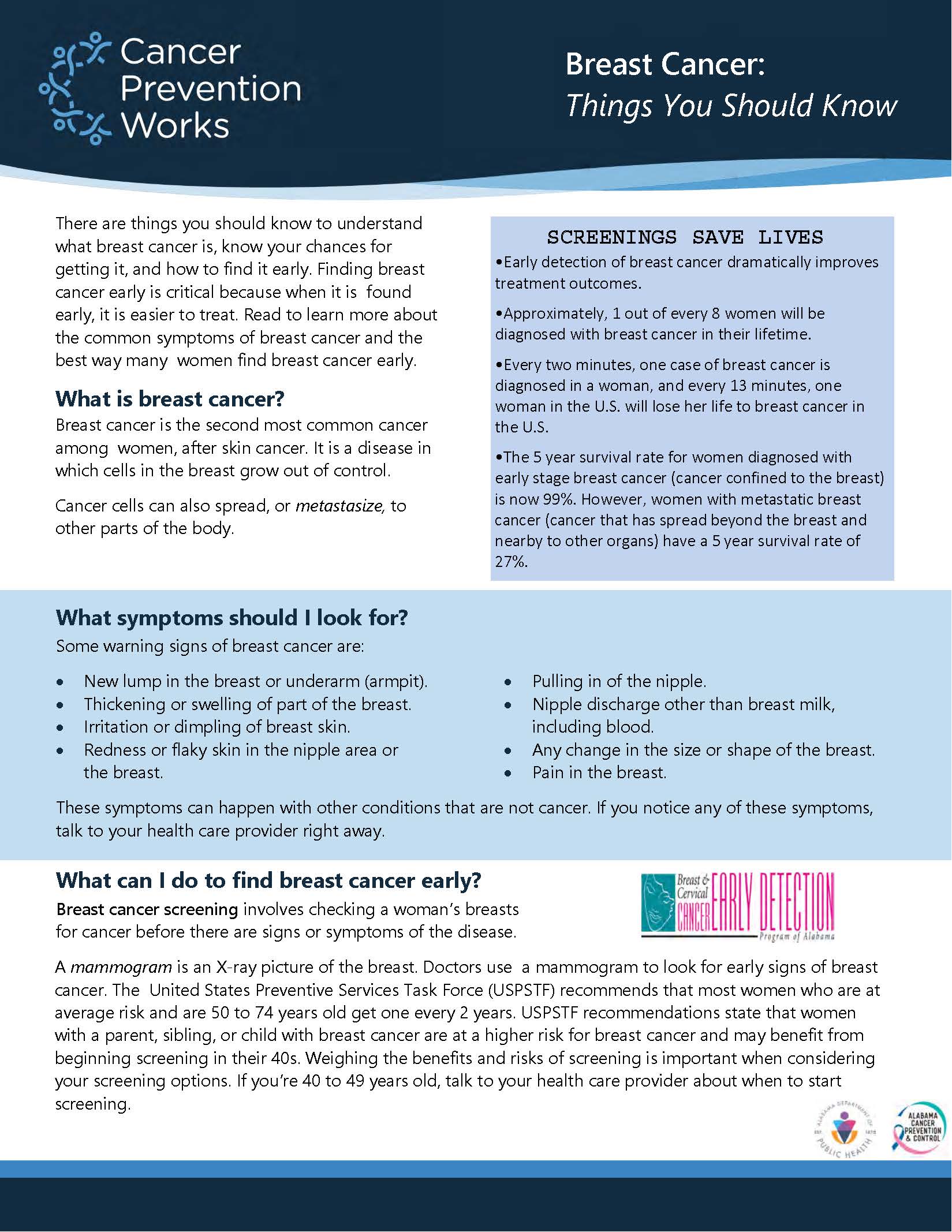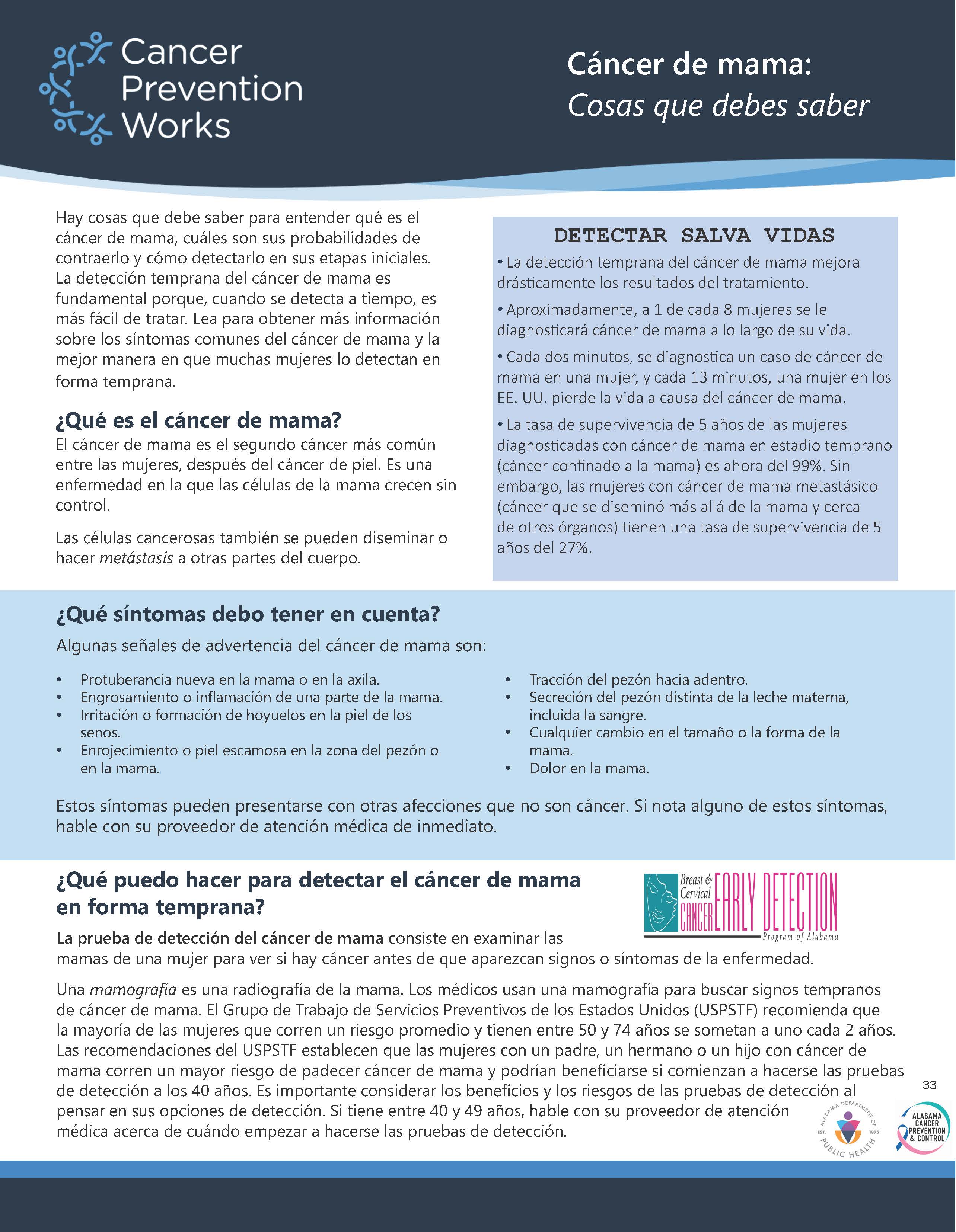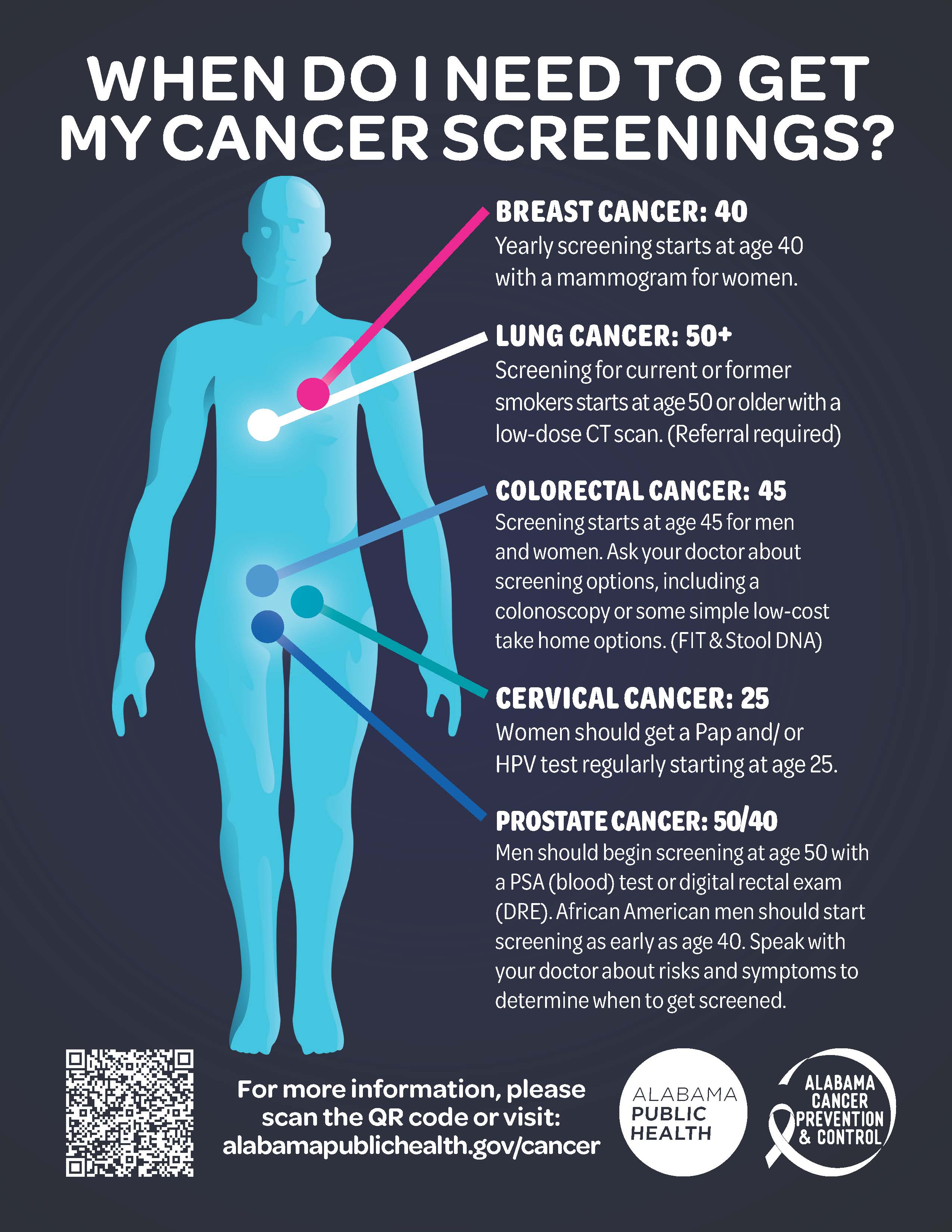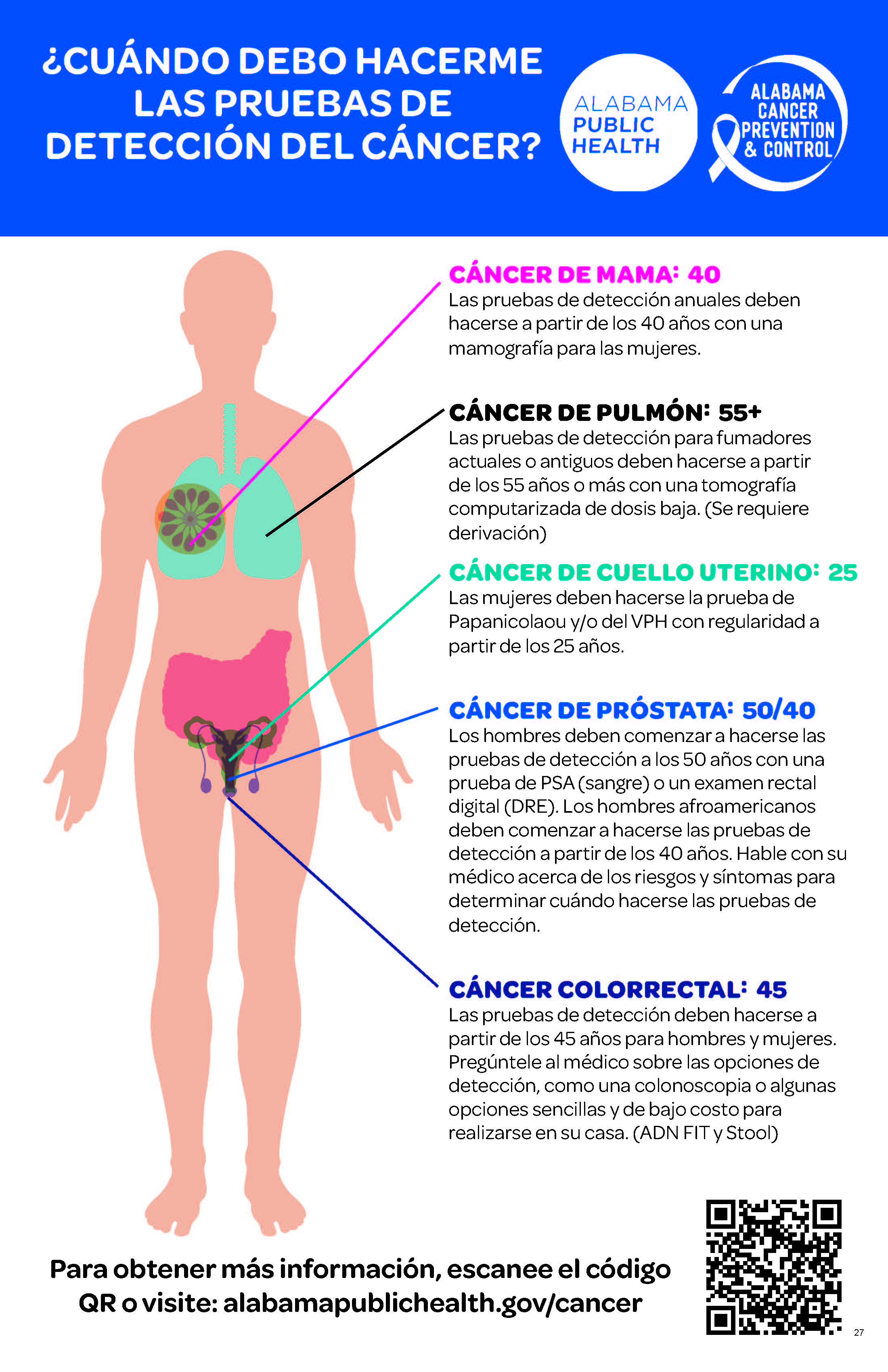- Cancer Division Home
- Cancer Control Coalition
- ASCR
- Breast & Cervical Cancer (ABCCEDP)
- Alabama WISEWOMAN Program
- Cancer State Plan
- Publications
- Breast Cancer
- Cervical Cancer
- Colorectal Cancer
- Lung Cancer
- Prostate Cancer
- Skin Cancer
- Survivorship: Life During and After Cancer
- HPV: Cervical Cancer Prevention
- Nutrition and Physical Activity
- Print Material
- Contact Us
Breast Cancer
What are the risk factors for breast cancer?
Studies have shown that your risk for breast cancer is due to a combination of factors. The main factors that influence your risk include being a woman and getting older. Most breast cancers are found in women who are 50 years old or older. Some women will get breast cancer even without any other risk factors that they know of. Having a risk factor does not mean you will get the disease, and not all risk factors have the same effect. Most women have some risk factors, but most women do not get breast cancer.
Risk factors you cannot change:
- Getting older. The risk for breast cancer increases with age. Most breast cancers are diagnosed after age 50.
- Genetic mutations. Women who have inherited changes (mutations) to certain genes, such as BRCA1 and BRCA2, are at higher risk of breast and ovarian cancer.
- Reproductive history. Starting menstrual periods before age 12 and starting menopause after age 55 expose women to hormones longer, raising their risk of getting breast cancer.
- Having dense breasts. Dense breasts have more connective tissue than fatty tissue, which can sometimes make it hard to see tumors on a mammogram. Women with dense breasts are more likely to get breast cancer.
- Personal history of breast cancer or certain non-cancerous breast diseases. Women who have had breast cancer are more likely to get breast cancer a second time. Some non-cancerous breast diseases such as atypical ductal hyperplasia or lobular carcinoma in situ are associated with a higher risk of getting breast cancer.
- Family history of breast or ovarian cancer. A woman’s risk for breast cancer is higher if she has a mother, sister, or daughter (first-degree relative) or multiple family members on either her mother’s or father’s side of the family who have had breast or ovarian cancer. Having a first-degree male relative with breast cancer also raises a woman’s risk.
- Previous treatment using radiation therapy. Women who had radiation therapy to the chest or breasts (for instance, treatment of Hodgkin’s lymphoma) before age 30 have a higher risk of getting breast cancer later in life.
Risk factors you can change:
- Not being physically active. Women who are not physically active have a higher risk of getting breast cancer.
- Being overweight or having obesity after menopause. Older women who are overweight or have obesity have a higher risk of getting breast cancer than those at a healthy weight.
- Taking hormones. Some forms of hormone replacement therapy (those that include both estrogen and progesterone) taken during menopause can raise the risk for breast cancer when taken for more than 5 years. Certain oral contraceptives (birth control pills) also have been found to raise breast cancer risk.
- Reproductive history. Having the first pregnancy after age 30, not breastfeeding, and never having a full-term pregnancy can raise breast cancer risk.
- Drinking alcohol. Studies show that a woman’s risk for breast cancer increases with the more alcohol she drinks.
What are the signs of breast cancer?
There may be no physical signs of breast cancer in the early stages. This is why it is so important for a woman to get screened regularly. If the cancer is caught early or in its precancerous form it can be removed before it spreads. Some warning signs of breast cancer are:
- New lump in the breast or underarm (armpit).
- Thickening or swelling of part of the breast.
- Irritation or dimpling of breast skin.
- Redness or flaky skin in the nipple area or the breast.
- Pulling in of the nipple or pain in the nipple area.
- Nipple discharge other than breast milk, including blood.
- Any change in the size or the shape of the breast.
- Pain in any area of the breast.
Keep in mind that these symptoms can happen with other conditions that are not cancer. If you have any signs or symptoms, be sure to see your doctor right away.
Why do you need to be screened for breast cancer?
Breast cancer screening means checking a woman’s breasts for cancer before there are signs or symptoms of the disease. Although breast cancer screening cannot prevent breast cancer, it can help find breast cancer early, when it is easier to treat. Talk to your doctor about which breast cancer screening tests are right for you, and when you should have them. See if you qualify for the Alabama Breast and Cervical Cancer Early Detection Program (ABCCEDP).
mammogram is an X-ray of the breast. For many women, mammograms are the best way to find breast cancer early, when it is easier to treat and before it is big enough to feel or cause symptoms. Having regular mammograms can lower the risk of dying from breast cancer. At this time, a mammogram is the best way to find breast cancer for most women of screening age.
Breast Cancer Statistics
The Alabama Cancer Statistics report presents the latest cancer incidence, mortality, and trends for the state of Alabama broken down by cancer groupings, race, sex, and county at diagnosis. The purpose of this report is to provide the latest cancer data for Alabama in order to assist partners, agencies, and organizations involved in cancer prevention efforts throughout the state as we continue to work toward reducing Alabama's cancer burden.
2023 Estimates
In 2023, an estimated 4,500 new cases of female breast cancer and approximately 720 female breast cancer deaths were expected to occur in Alabama.
Incidence Rates
The female breast cancer incidence rate in Alabama is 121.8 – significantly lower than the U.S. rate of 126.8. Black females in the state have a significantly higher breast cancer incidence rate than white females, with a rate of 126.8 versus 119.4.
The following maps summarize the information found in tables three through eight of the latest version of the Alabama Cancer Facts and Figures.
Mortality Rates
The female breast cancer mortality rate in Alabama is 21.3 – significantly higher than the U.S. rate of 20.2. However, both white females and black females in Alabama have slightly lower mortality rates than their U.S. counterparts. Black females in the state have a significantly higher breast cancer mortality rate than white females, with a rate of 27.4 versus 19.4.
Breast Cancer Treatment Education Brochure
- Breast Cancer Treatment Education Brochure
Full page 8 1/2" x 11" - Breast Cancer Treatment Education Brochure
4-panel brochure - Breast Cancer Treatment Education Act of 2013 (Act 2013-284)
Breast Cancer Facebook Page
The CDC’s Division of Cancer Prevention and Control has a Facebook page dedicated to the topic of breast cancer. The page, targeted to public health partners, healthcare providers, and the public, was created to provide an interactive forum dedicated to preventing and reducing the effects of breast cancer on women. Please log onto Facebook and “follow” their page, engage with their content, and share with your followers on Facebook. We hope you find this to be a valuable resource in the fight against breast cancer.
You can find the new CDC Breast Cancer page at www.facebook.com/CDCBreastCancer.
Page last updated: September 1, 2023








